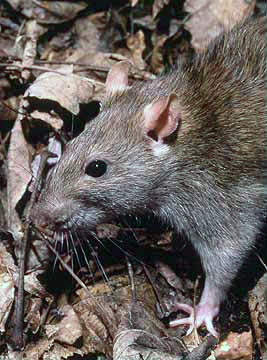|
| Query: Brown norway rat | Result: 2nd of 10 | |
Brown Rat (Rattus norvegicus) - Wiki
| Subject: | Brown Rat (Rattus norvegicus) - Wiki
| |

| Resolution: 267x360
File Size: 122460 Bytes
Date: 2006:12:06 14:51:24
Upload Date: 2007:08:10 17:02:28
|
Brown Rat
From Wikipedia, the free encyclopedia
[Photo] Rattus norvegicus, the Brown Rat. Picture taken from the U.S. National Park Service site at http://www.nps.gov/cuva/kidstuff/alphabet/n.htm
The brown rat, common rat, Norway rat, Norwegian rat or wharf rat (Rattus norvegicus) is one of the best-known and common rats, and also one of the largest. It is not known for certain why it is named Rattus norvegicus (Norwegian rat) as it did not originate in Norway, but John Berkenhout, the author of the 1769 book "Outlines of the Natural History of Great Britain", is most likely responsible for the misnomer. Berkenhout gave the brown rat the binomial name Rattus norvegicus believing that the rat had migrated to England from Norwegian ships in 1728, although no brown rat had entered Norway at that time, instead coming from Denmark. Thought to have originated in northern China, this rodent has now spread to all continents (except Antarctica) and is the dominant rat in Europe and much of North America. It lives wherever humans live, particularly in urban areas. Selective breeding of Rattus norvegicus has produced the laboratory rat, an important model organism in biological research, as well as pet rats.
Description
The fur is coarse and usually brown or dark grey, the underparts are lighter grey or brown. The length can be up to 25 cm (10 in.), with the tail a further 25 cm (the same as the body length). Adult body weight averages 350 g in males and about 250 g in females, but a very large individual can reach 500 g. Rats weighing over a kilogram are exceptional, and stories of rats as big as cats are exaggerations, or misidentifications of other rodents such as the coypu and muskrat. Brown rats have acute hearing and are sensitive to ultrasound, and also possess a very highly developed olfactory sense. Their average heart rate is 300 to 400 beats per minute, with a respiratory rate of around 100 per minute. Their vision is poor and they are unable to detect colour and are blind to long-wave light.
Food, habitat and behavior
The brown rat is a true omnivore and will consume almost anything, but with cereals forming a substantial part of the diet. Martin Schein, founder of the Animal Behavior Society in 1964, studied the diet of brown rats and came to the conclusion in his paper "A Preliminary Analysis of Garbage as Food for the Norway Rat" that the most-liked food of brown rats was (in order) scrambled eggs, macaroni and cheese, and cooked corn kernels. Their least-liked food was raw beets, peaches, and raw celery. They are usually active at night and are good swimmers, both on the surface and underwater, but (unlike the related Black rat Rattus rattus) are poor climbers. They dig well, and often excavate extensive burrow systems. A 2007 study found rats to possess metacognition, a mental ability previously only found in humans and some primates.
Breeding
The brown rat can breed throughout the year if conditions are suitable, a female producing up to five litters a year. The gestation period is only 1-2 months and litters can number up to fourteen, although seven is common. The maximum life span is up to three years, although most barely manage one. A yearly mortality rate of 95% is estimated, with predators and interspecific conflict as major causes. Brown rats live in large hierarchical groups, either in burrows or subsurface places such as sewers and cellars. When food is in short supply, the rats lower in social order are the first to die. If a large fraction of a rat population is exterminated, the remaining rats will increase their reproductive rate, and quickly restore the old population level.
Rats live almost everywhere people live. It is often said that there are as many rats in cities as people, but this varies from area to area depending on climate, etc. It is probable that New York City (with a severe winter climate), for instance, has only 250,000 rats, not eight million. However, the UK official National Rodent Survey found a 2003 UK population of 60 million brown rats, about equal to the UK human population; winters in Britain are much warmer, making rat survival higher. Brown rats in cities tend not to wander extensively, often staying within 20 meters (65 ft) of their nest if a suitable concentrated food supply is available, but they will range more widely where food availability is lower.
...
http://en.wikipedia.org/wiki/Brown_Rat
| The text in this page is based on the copyrighted Wikipedia article shown in above URL. It is used under the GNU Free Documentation License. You may redistribute it, verbatim or modified, providing that you comply with the terms of the GFDL. |
|
Comments |
|---|
| | MELICA |
|
| please add me on yourlist |
^o^
Animal Pictures Archive for smart phones
^o^
|
|
|

